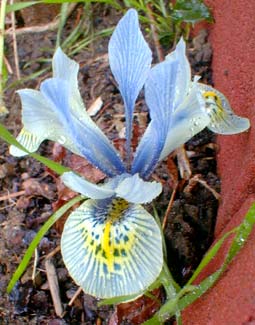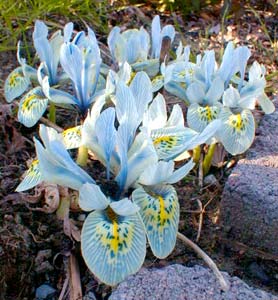
'Katherine Hodgkin'
Dwarf Iris; or,
Orchid Iris
"Irises, beloved of Pindar."
-Florence Taber Holt,
1920
1920
In comparison to the closely related similar-in-size Iris reticulata, the majority of whose varieties range from dark blue to dark purple, I. histroides var major x winogradowii 'Katherine Hodgkin' is a horse of another color.
This stand-out of a dwarf iris is sometimes sold as a variety of I. reticulata, but it is a hybrid of two other closely related iris species, & are similarly suited to containers or rockeries or front garden borders. The wild blue I. histroides is native to eastern Turkey (Anatolia). The rare primrose-yellow I. winogradowii is native to the Caucasus. This hybrid captures the colors of both its parents with considerable drama.
 It has the palest powder blue or bluish grey standards & a yellow crest, thinly veined with dark blue. It changes color a bit from when it first opens to as it ages, & it can be a slightly different shade from one year to the next, but there is no mistaking it for anything else even with a range of variation. It somewhat resembles the bluish-white & green-veined I. reticulata 'Natascha,' but is definitely its own flower, & blooms ahead of the appearance of its grass, unlike I. rediculata varieties. It's quite rightly a recipient of the 1996 Award of Garden Merit.
It has the palest powder blue or bluish grey standards & a yellow crest, thinly veined with dark blue. It changes color a bit from when it first opens to as it ages, & it can be a slightly different shade from one year to the next, but there is no mistaking it for anything else even with a range of variation. It somewhat resembles the bluish-white & green-veined I. reticulata 'Natascha,' but is definitely its own flower, & blooms ahead of the appearance of its grass, unlike I. rediculata varieties. It's quite rightly a recipient of the 1996 Award of Garden Merit. They like moist well-drained soil in spring & relatively dry conditions during summer dormancy. It flowers February or March, in our garden as early as January, & stands four to eight inches tall in full flower.
This very hardy early bloomer withstands freezing rains & snowfall, thriving in zones 5-9, stretchable to zone 4. Unlike equally small crocuses, this dwarf iris doesn't care if it is overcast, & will be in full display rain or shine. Nor is it battered down by heavy rainfall, but always stands straight & sturdy.
Compared to varieties of I. reticulata the blooms for which often seem to be very transient, 'Katherine Hodgkin's' blossoms are the longest-lasting of any iris species we have.
We planted sixteen autumn bulbs along the ledge of a roadside raised bed. Early in the second week in February (2005) the first of these burst into full flower, though the majority were still buds awaiting another week's passage. Of the dwarf irises in 2005, only the wild blue I. reticulata bloomed earlier, being already a full bright drift of blossoms when 'Katherine Hodgkins' burst into flower. But in 2006 the wild blues bloomed after 'Katherine' but I. reticulata 'Purple Gem' bloomed much earlier than any other dwarf Iris, & 'Katherine' was in full bloom by the last week of January.
The photo at top shows the first one to appear in the garden, standing a scant four inches tall. 'Katherine Hodgkin' easily naturalizes, increasing in numbers through the years. Indeed, reproduction of the bulbs is so swift that if you buy a package of eight, chances are good there'll actually be ten or a dozen in the package, so many of the bulbs will already be splitting in two or having bulblets started.